Horses are a wonderfully diverse species that vary greatly in size, shape, and color. As a result of selective breeding throughout history, there are now over 600 horse breeds on the planet.
However, while each of these breeds has a unique set of characteristics, they all fit into five broader horse types. These types have developed over time through the need for horses that suit a certain type of work.
For example, horses used for riding and covering long distances within a short time needed to be agile and have superior stamina. Whereas, horses that worked on farms and pulled heavy goods needed sheer muscle power combined with a calm temperament.
What are the Types of Horse?
The five types of horses are hotblood, warmblood, draft, pony, and miniature. These types of horse breeds are defined by conformation, temperament, physical ability, and intended use.
While the exact origins of these horse types are obscure, there are various explanations as to where they came from.
Based on the current understanding, the two oldest types of horses are hot-blooded and draft. Experts believe that warmblood, pony, and miniature breeds diverged from these two over time.
What are the Differences Between Each Type of Horse?
Hotbloods have a lean appearance and are known for their speed, endurance, and spirit. Coldbloods, on the other hand, are heavily built with powerful musculature and a docile temperament. Warmbloods combine the best of both and are famed for their athletic ability and steady nature, making them ideal for equestrian sport.
Meanwhile, ponies are renowned for their small stature and impressive strength relative to size. They have characteristic features that make them unique among all horse types, such as a large head, small ears, short legs, and abundant mane and tail.
Miniature horses might stand closer to ponies in size, but they are considered horses in the equestrian world. This is because they have the body proportions of a full-size horse rather than a pony.
Although most horse breeds are extremely versatile, they are generally better suited to certain tasks depending on their type.
Hot-blooded breeds, for example, excel at racing and endurance events, while draft horses make superb farm and carriage horses.
Below we take a more in-depth look into each type of horse.
Hotblood Horse
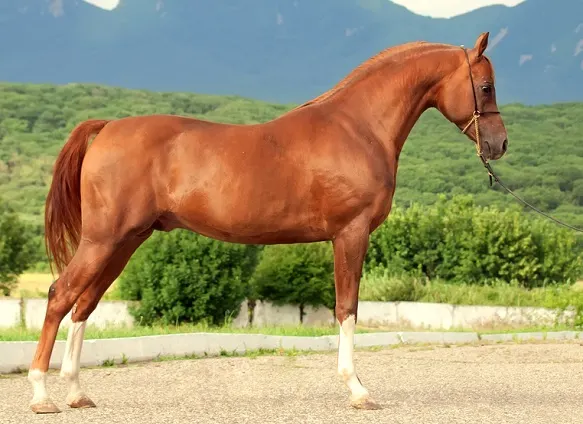
Arabian horse. anakondasp / Shutterstock.com
Hot-blooded horses have a spirited temperament and a body that’s built for speed and endurance. They are light riding horses ranging from 800 to 1,000 pounds (360 to 450 kg). In terms of height, they are in the medium range, measuring 14 to 16 hands at the withers.
Horses in this category have straight or concave heads, slender necks, sinewy legs with steel-like tendons, and a high set tail. They typically have thin skin and a very short coat, even in the winter. They are also highly intelligent, quick learners with a bold and fiery attitude.
Hotblood Horse Origins
This horse type originates in the Middle East and North Africa, where environmental conditions are ideal for the development of light and fast horses with superior stamina.
The oldest hot-blooded breeds were developed by nomadic tribes who held their horses in high regard. They put a great emphasis on the relationship between horse and human in their breeding, which is why this horse type is so intelligent and affectionate.
In the Middle Ages, hot-blooded horses were considered very valuable in Western countries. Gradually, their numbers increased in Europe via war and trade, and more and more breeding stables were established.
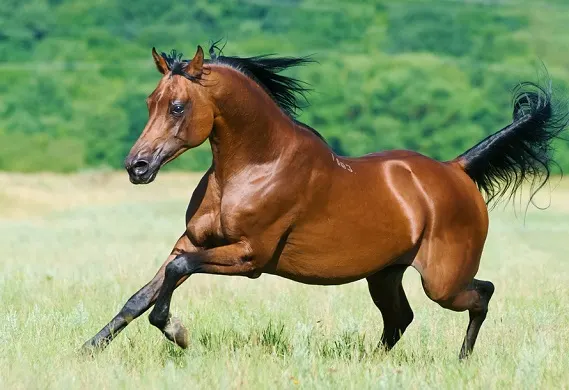
Makarova Viktoria / Shutterstock.com
In the United Kingdom, the crossing of Arabian, Barb, and Turkoman horses with native breeds gave rise to the Thoroughbred.
Hotbloods have also been used to add speed and stamina to heavier breeds, creating the modern-day warmblood.
What horse breeds are hot bloods?
Common Hot-blooded horse breeds are Akhal-Teke, Arabian, Barb, Thoroughbred, and the crosses of these. While these horse breeds perform best in racing and endurance, their versatility makes them suitable for almost any riding activity.
One particular cross between hotblood breeds, the Anglo-Arabian, even became its own breed. According to the breed, registry, Anglo-Arabians must descend from Thoroughbred and Arabian parents and must have at least 12.50% Arabian blood.
Throughout history, hot-blooded breeds have been used to improve other horse breeds by adding agility, refinement, stamina, and strong bone.
Today, most modern horse breeds have traces of either Thoroughbred or Arabian bloodlines in their pedigree.
Hotblood Horse Uses
As mentioned above, hot-blooded horses perform best in speed and endurance events. Today, the Thoroughbred breed dominates the sport of horse racing, while the Arabian is the king of endurance racing.
Meanwhile, Anglo-Arabians have become a popular choice for show jumping, eventing, and hunting. Although each hot-blooded breed has its own special talent, they are highly adaptable and will do well in most riding disciplines.
Hotbloods have also been used extensively to produce partbreds, show ponies, and improve existing breeds.
Warmblood Horse

Dutch Warmblood. Zuzule / Shutterstock.com
A warmblood horse is a type of horse that’s in between a hotblood and a draft. They are heavier in frame than hot-blooded breeds, but still extremely elegant and athletic. Common warmblood horse breeds are Hanoverian, Oldenburg, and Dutch Warmblood.
Most warmblood horses are similar in height to hotbloods, averaging 14 to 16 hands. However, they weigh slightly more with a typical range of 1,200 to 1,700 pounds (550 to 750 kg).
Warmblood Horse Origins
Warmblood horse breeds derive from draft-type horses that have been “upgraded” by hotblood breeds. Confusingly, the term “warmblood” is used in various ways depending on the breed’s purpose.
Classic warmbloods are bred to perform in high-level equestrian sport, mainly show jumping, dressage, and eventing. At the same time, horse breeds that don’t fit into the other four categories are also referred to as warmbloods.
Classic warmbloods are different from other horse breeds in that they have an open studbook, enabling the inflow of outside bloodlines. As a result, most warmblood horse breeds are not considered a “true” breed.
This approach makes it possible for warmblood breeders to continuously develop the breed towards a specific goal. Most warmbloods are either bred for show jumping or dressage, as well as eventing and driving.
Warmblood Horse Breeds

Hanoverian horse. Shawn Hamilton / Shutterstock.com
Warmbloods are the most numerous horse type, and the majority of existing breeds fall in this category.
Most warmbloods bred for sport were developed in Europe, particularly Germany. The most famous German warmbloods are the Holsteiner, Hanoverian, Oldenburg, and Trakehner.
Other classic warmblood breeds include the Dutch Warmblood, Belgian Warmblood, Selle Français, and the Swiss Warmblood. Almost all Olympic dressage, show jumping, and eventing champions have been warmbloods.
Most American horse breeds also belong in the warmblood category. A few examples are the Quarter Horse, Paint Horse, Mustang, Appaloosa, Morgan, Standardbred, Tennessee Walking Horse, and Paso Fino.
Warmblood Horse Uses
Since the end of World War II, warmbloods have become hugely popular as recreational and sport horses. Like hotbloods, they are very versatile horses with the potential to perform well in most disciplines.
Lighter warmbloods are mainly used for competition, hobby, and trail riding purposes. In America and Australia, warmblood breeds are widely used for western riding, ranching, and rodeo.
Meanwhile, heavier warmbloods like the Oldenburg, Hackney, and Cleveland Bay make great family and driving horses.
Are warmbloods good for beginners?
Since they are calmer than hotbloods and lighter than draft horses, warmbloods are a good choice for beginners. However, any well-trained, good-natured and experienced horse will suit a beginner, regardless of type.
When choosing a horse for a beginner, keep in mind that it’s the horse’s personality and attitude that counts. Warmbloods are still very powerful and can get out of control if they have too much built-up energy.
Good beginners’ horses can be found in every category, and we should always assess each horse on an individual basis.
Draft Horse

Vera Zinkova / Shutterstock.com
Draft horses are the giants of the equestrian world. They are famous for their massive measurements, remarkable strength, and docile temperament.
An average draft horse can be anywhere between 16 to 19 hands and 400 to 2,000 lb (640 to 910 kg). However, the world’s largest draft horse exceeded even these measurements, standing at 21.2 hands and weighing an incredible 3,360 lb (1,524 kilograms)!
Draft horse breeds are also known as cold-blooded or work horse breeds and are easy to recognize from their powerful hindquarters, heavy bone, and abundant feathering on the legs. They are generally late maturers and surprisingly economical to feed.
Draft Horse Origins
This horse type likely developed in Northern Europe from a prototype known as the “Forest Horse”. Prior to the industrial revolution and the mechanization of agriculture, draft horses were indispensable assets to our society.
Historically, draft horses have been used for farming, transport, logging, war, and the hauling of heavy goods. At the turn of the 20th century, thousands of draft horses were exported to the United States. Most of these were Percherons, Belgians, Shires, and Clydesdales.
Sadly, the number of draft horses declined heavily in the 20th century due to their use in the World Wars and falling demands for working horses. As a result, many breeds such as the Shire Horse or Clydesdale became endangered.
Examples of Draft Horse Breeds
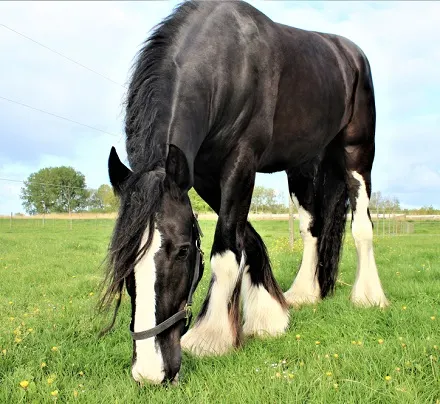
Shire horse. Sanne van der Vlerk-Zwirs / Shutterstock.com
Although not as versatile as warmbloods, many draft horse breeds survived into modern times.
In North America, the two most common draft horse breeds are the Percheron and the Belgian. The United States has also developed its own draft breed, the American Cream Draft. This unique breed is relatively new and has only existed for less than 100 years.
Other well-known draft horse breeds include the Ardennes, Boulonnais, Breton, Clydesdale, Shire, Irish Draft, Suffolk Punch, Italian and Russian Heavy Draft.
What are draft horses best for?
Today, draft horses are mainly used for forestry and driving, as well as riding and showing. However, some smaller farms still use these animals for agriculture around the world.
Moreover, draft breeds are often crossed with light riding horses such as the Thoroughbred to create a heavy hunter-type horse. The Irish Draft and Thoroughbred cross, for example, is a popular combination in the UK.
Draft crosses have also played an important role in the development of various warmblood breeds. The addition of heavy bloodlines often increased the height, power, and scope of the offspring, making these horses ideal for elite competition.
Can draft horses be ridden?
While most draft horses are used for pulling and driving, they can also be ridden to some extent. Lighter draft horse breeds such as the Percheron or the Irish Draft can even perform under saddle.
Although most draft horses are not meant for riding, they can still make great hobby riding horses. It’s also not uncommon for draft horses to serve as police mounts due to their calm nature and strength.
Pony

Daisy Shakespeare / Shutterstock.com
Ponies are essentially small horses with characteristic features and a maximum height of 14.2 hands (147 cm).
Other than their small height, typical pony-like features include a large head with small ears, thick neck, thick mane and tail, and proportionally short legs.
While most pony breeds are rather stocky and round in frame, some are more slender and athletic as a result of warmblood influence.
Origins
Ponies are more closely related to draft horses than any other horse type. In fact, scientists believe they descended from the early draft subtype that used to live in Northern Europe.
Due to their origin, most pony breeds are remarkably surefooted and can easily navigate through rough terrain. They are also surprisingly strong for their size, and many pony breeds can carry a full-sized adult. This is the result of the higher bone density they inherited from their draft ancestors.
Throughout history, ponies have become popular working animals that could even replace draft horses in transport and agriculture. In addition, ponies were much lower maintenance than other horse types and could survive harsh weather conditions.
By the 20th century, riding became more widespread as a leisure activity. As a result, several pony breeds received Arabian or other blood to increase their athletic abilities.
Are there different breeds of ponies?
Due to selective breeding, there are many different pony breeds today. The most common ones are the Shetland Pony, Connemara, Welsh Pony and Cob, Pony of the Americas, Australian Pony, and Hackney Pony.

Rita_Kochmarjova / Shutterstock.com
Interestingly, not all horse breeds that are shorter than 14.2 hands are ponies. Examples are the Icelandic, Haflinger, and Fjord Horse breeds that are all referred to as “horses” by their breed societies.
To learn more, read our article 11 Interesting Facts About Ponies.
Uses
Ponies were traditionally used for packing and transport, as well as riding and driving. During the Industrial Revolution, many worked in the coal mines of Great Britain and the United States.
Today, ponies are most popular by far as children’s mounts. Some breeds like the Connemara or Welsh Cob can also be ridden by small adults. Others like the Hackney Pony are primarily used in harness.
Most pony breeds are intelligent, friendly, and easy to handle, making them ideal for beginners. At the same time, ponies are often described as “cheeky” and “cunning” due to their rebellious nature.
In truth, most of these behavioral problems are underlined by training issues that can be easily corrected by proficient handling.
Miniature Horse
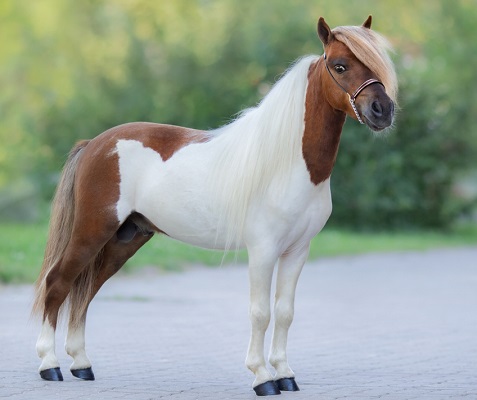
American Miniature horse. Abramova Kseniya / Shutterstock.com
Miniature horses are typically shorter than 34–38 inches (86–97 cm) at the withers, making them the smallest horse type. Despite their size, they retain the proportions of a full-size horse and are considered “horses” by their breed societies.
Essentially, miniatures are scaled-down versions of larger horse breeds. At present, only a handful of breeds have miniature versions, such as the Arabian and Gypsy Vanner. However, more and more breeders are committing to scaling down a specific breed, so we should see more in the future.
Miniature Horse Origins
Miniature horses are the product of centuries-long selective breeding. They were originally developed in Europe around the 1600s and soon became popular pets of the aristocracy.
Alongside ponies and small horses, miniatures also worked in coal mines throughout the United States and Britain. In the mid-1900s, public interest in miniature horses began to grow and they became popular in various equestrian disciplines.
Miniature Horse Breeds
There are only a small number of miniature horse breeds to date, the most famous of which is the Falabella. This breed was developed in Argentina by Patrick Newtall in the 1850s.
Following Newtall’s death, his son-in-law Juan Falabella continued the breeding program. In addition to the existing bloodlines, he used Thoroughbred, Shetland Pony, and Welsh Pony blood to develop the breed.
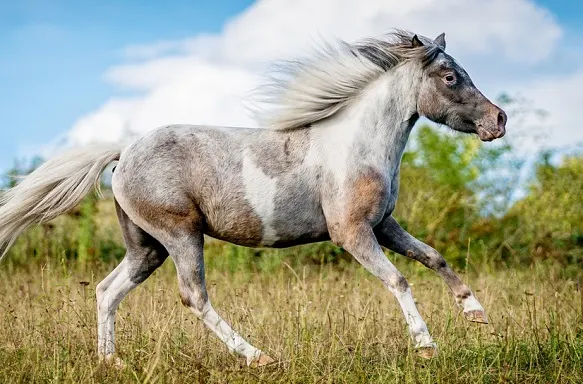
American Miniature Horse. Credit: www.MartinaBurianova.cz / Shutterstock.com
Eventually, Falabella achieved a consistently small size throughout his herd. The breed is now the smallest horse breed in the world, standing at only 24-28 inches (61-71 cm) on average.
Other miniature breeds include the South African Miniature Horse and American Miniature Horse.
Miniature Horse Uses
Due to their small size, miniature horses are never used for riding but as family pets and companion animals. However, they still retain the instinctive nature of their large relatives and must be cared for like a full-size horse.
Miniatures can also be trained as service animals and are used in various forms of equine therapy. They are also suitable for driving, showing, and equine agility.
How long do mini horses live?
On average, mini horses live for 25 to 35 years, which is slightly longer than most horses. However, they can also have numerous health issues that can shorten their lifespan.
Some common problems miniature horse owners might encounter are overfeeding, dental issues, metabolic disorders, and breeding difficulties.
Moreover, Falabellas are also prone to genetic abnormalities, as the breed has been created with considerable inbreeding.
Source: horseyhooves.com








